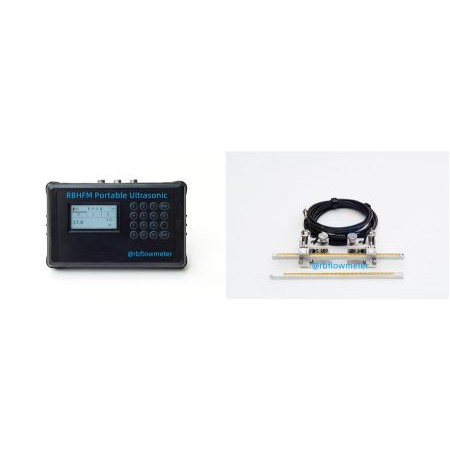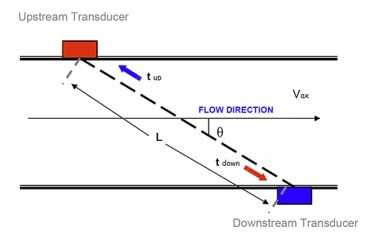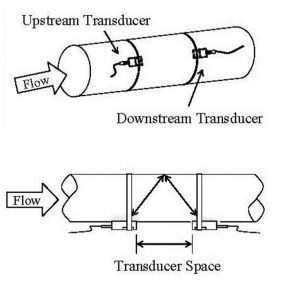



RBHFM Portable Ultrasonic Flow Meter working Principle:
Here’s how ultrasonic flow meters work.
Ultrasonic flow meters use sound waves at a frequency beyond the range of hearing (typically 0.5, 1, or 4 MHz). This ultrasound signal is sent into a stream of flowing liquid by using wetted (insertion) transducers that make direct contact with the liquid or external (clamp-on) transducers that send the ultrasound through the pipe wall. Clamp-on ultrasonic flow meters allow users to measure the volumetic flow rate of a fluid in a pipe without having to penetrate the pipe which decreases installation and maintenance costs.
A typical transit-time ultrasonic liquid flow meter utilizes two ultrasonic transducers that function as both ultrasonic transmitter and receiver. The ultrasonic flow meter operates by alternately transmitting and receiving a burst of ultrasound between the two transducers by measuring the transit time that it takes for sound to travel between the two transducers in both directions. The difference in the transit time (∆ time) measured is directly proportional to the velocity of the liquid in the pipe.

Below is a drawing of a typical application using the most common, V (2 pass) mounting method with clamp-on transducers. In this application, the ultrasound is transmitted from the first transducer and travels through the pipe wall, through the liquid, then reflects off the back wall of the pipe, then travels through the pipe wall, and is picked up by the second transducer.
The same process is then repeated in reverse as the second transducer transmits the ultrasound. The time difference between the times of flight up and down is the ∆ Time. When the liquid in the pipe is not moving, the ∆ Time would be zero.

To calculate the velocity of the liquid, you need to convert the raw ∆ Time into the velocity of the liquid in the pipe. The angle of the ultrasound path is calculated by knowing the speed of sound of the pipe and the liquid. This angle is used in a common trigonometry equation to convert the ultrasound path into a straight line in the pipe. This will be the velocity of the liquid in the pipe.
Once the velocity is known, it’s just a matter of converting it into a flow rate by multiplying it times the cross-sectional area of the pipe, as with any velocity based flow meter.
Ease-of-Installation: The largest benefit of any “clamp-on” transit-time flow meter is the ease-of-installation. While still requiring sections of straight pipe upstream of the measurement location, the process does not require shutting the system down to install, making maintenance and upkeep of transit-time meters much more attractive.
Low maintenance: There are no blades to wear out or bearings to replace as in turbine meters, nor are there electrodes that can foul over time as in magnetic flow meters.
The artical is from Dec 05, 2017
RBHFM-P Portable Ultrasonic Flow Meter(measurment) Features:
RBHFM-P Portable Ultrasonic Flow Meter Specification:
|
Flow range |
±0.03 ft/s ~ ±40 ft/s (±0.01 m/s~ ±12 m/s) |
|
|
Accuracy |
±1% of measured value |
|
|
Pipe size |
Clamp-on:1"~48"(25mm~1200mm) |
|
|
Fluid |
Single medium liquid |
|
|
Pipe material |
Carbon steel,stainless steel,PVC and other compact material pipe |
|
|
Function specifications |
||
|
Outputs |
Analog output: 4~20mA, Max 750 Ω . Modbus: RS485 |
|
|
SD card |
16G |
|
|
Interval |
1 ~ 99999seconds |
|
|
Key broad |
Digital keys |
|
|
Display |
240*128 back lit LCD |
|
|
Power supply |
Rechargeable Lithium Battery Power,3000mAh (Continuous operation of main battery 16 hours). |
|
|
Temperature |
Transmitter: -40℃~60℃ Transducer: -40℃~80℃ (-40℃~80℃ is standard; -40℃~130℃ is an option) |
|
|
Humidity |
Up to 99% RH,non-condensing |
|
|
Physical specifications |
||
|
Transmitter |
NEMA13,IP54. |
|
|
Transducer |
Encapsulated design,IP68 |
|
|
Transducer cable |
Standard cable length: 5m (16ft). |
|
RBHFM-P Portable Ultrasonic Flow Meter Model Selection:
| The RBHFM Portable Transit time Ultrasonic Flow/Heat Meter Model Selction | |||||||
| RBHFM-P | Code | Type of Transmitter | |||||
| F | Ultrasonic Flow Meter | ||||||
| H | Ultrasonic Energy/Btu Meter function( RTD) | ||||||
| RBH Type of transducers(Pipe range: DN25-1200mm) | |||||||
| 1 | Clamp-on, IP68. Operating temperature: -40℉ ~ +176℉(-40℃ ~ +80℃) | ||||||
| 2 | Clamp-on, IP68. Operating temperature: -40℉ ~ +266℉(-40℃ ~ +130℃) | ||||||
| I | Insertion, IP68. Operating temperature: -40℉ ~ +266℉(-40℃ ~ +130℃) | ||||||
| Type of mounting track | |||||||
| S | Single guide mounting type bracket | ||||||
| D | Dual guides mounting type bracket | ||||||
| Transducers cable length | |||||||
| 5 | D series type of cable Standard 5m (16ft) with mounting track. | ||||||
| X | XX is the length you need for cables, Maximum lengthen to 30m. | ||||||
| Temperature sensor | |||||||
| N | Without | ||||||
| 1 | A pair of clamp on PT1000 sensor 9m | ||||||
| Datalogger | |||||||
| N | Without | ||||||
| 1 | With SD card | ||||||
| Remark: Model selection sample: | |||||||
| 1. standard configuration: RBHFM-F-1S5NN RBHFM series Portable Ultrasonic Flow Meter , RBH type transducer, -40℃ ~ +80℃, IP68 5m cables with single guide mounting track. Without tenperature sensor and datalogger. |
|||||||
RBHFM Portable Ultrasonic Flow Meter Application:
RBHFM Portable Ultrasonic Flow Meter catalog
RBHFM Portable Ultrasonic Flow Meter manual
Magmeters
Ultrassonic Flow Meter
Coriolis, Thermal Mass Flow Meter
Other Process Instrument